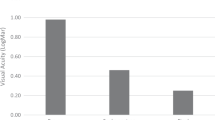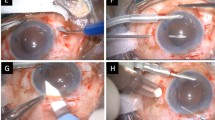Abstract
Background/Objective
To evaluate the outcomes of trans-scleral sutured posterior chamber black diaphragm intraocular lens (BDIOL) (Morcher®) implantations over 11 years.
Subjects/Methods
Retrospective case-series of patients, who underwent BDIOL implantation, identified from electronic patient records system from 2006 to 2016, Moorfields Eye Hospital. Demographics, pre/post-operative, final best-corrected visual acuity (BCVA), diagnosis, symptomatic improvement, intraoperative and postoperative complications immediate or late were collected and analysed to relate outcomes to surgical indication.
Results
Forty eyes of 38 patients (F:M 1:2.8) underwent BDIOL implantation with a mean surgical age of 46.6 years and follow-up of 44.5 months (range of 8–132 months). Indications included 23(57%) ocular trauma, 7(17%) congenital aniridia, 7(17%) iatrogenic lens and/or iris loss, and 3(7%) infectious keratitis. Mean preoperative BCVA was 1.64 logMAR and mean final postoperative BCVA was 0.94 logMAR with an average improvement in BCVA of 0.23 logMAR, equivalent to 1.5 lines of Snellen visual acuity. Visual results varied according to indications. Infectious cause patients had the greatest vision improvement (−0.7 logMAR), followed by trauma (−0.3 logMAR), and 25% of these achieved vision of 0.3 logMAR (6/12 in Snellen acuity) or better. Conversely, the aniridia group had the least improvement (worsened vision of 0.01 logMAR), 17 patients (42%) reported subjective improvement.
Conclusion
BDIOLs achieve reasonably good visual outcomes in eyes with complex vision threatening pathology. No significant intra-operative complications are documented and most post-operative complications are related to the pre-existing pathology. Post – trauma and iatrogenic aniridia have better outcomes compared to congenital aniridia.
This is a preview of subscription content, access via your institution
Access options
Subscribe to this journal
Receive 18 print issues and online access
$259.00 per year
only $14.39 per issue
Buy this article
- Purchase on Springer Link
- Instant access to full article PDF
Prices may be subject to local taxes which are calculated during checkout

Similar content being viewed by others
Data availability
Data are available upon request to the corresponding author.
References
Mekkawi TF. Scleral Fixation of Iris Diaphragm Intraocular Lens in Patients with Traumatic Aniridia. J Clin Exp Ophthalmol. 2011;2:184.
Weissbart SB, Ayres BD. Management of aniridia and iris defects: An update on iris prosthesis options. Curre Opin Ophthalmol. 2016;27:244–9.
Beltrame G, Salvetat ML, Chizzolini M, Driussi GB, Busatto P, Di Giorgio G, et al. Implantation of a black diaphragm intraocular lens in ten cases of post-traumatic aniridia. Eur J Ophthalmol. 2003;13:62–8.
Peter C. Intra-ocular lenses and implants. In: Intra-Ocular lenses and implants. London: HK Lewis and Co Ltd; 1964.
Sundmacher R, Reinhard T, Althaus C. Black-diaphragm intraocular lens for correction of aniridia. Ophthalmic Surg. 1994;25:27–31.
Hoffman RS, Fine IH, Packer M. Scleral fixation without conjunctival dissection. J Cataract Refract Surg. 2006;32:1907–12.
Miller KM, Kuo A, Olson MD, Masket S. Safety and efficacy of black iris diaphragm intraocular lens implantation in eyes with large iris defects: Report 4. J Cataract Refract Surg. 2018;44:686–700.
Qiu X, Ji Y, Zheng T, Lu Y. Long-term efficacy and complications of black diaphragm intraocular lens implantation in patients with traumatic aniridia. Br J Ophthalmol. 2015;99:659–64.
Al-Rashidi SH. Black Diaphragm Intraocular Lens Implantation in Patients with Aniridia. J Ophthalmic Vis Res. 2019;14:27–31.
Leck A, Matheson M, Tuft S, Waheed K, Lagonowski H. Scedosporium apiospermum keratomycosis with secondary endophthalmitis. Eye. 2003;17:841–3.
Li J, Li D, Wu J, Dong X. Over 10-year follow-up outcomes and failure analysis of black diaphragm intraocular lens implantation in traumatic Aniridia. Acta Ophthalmol. 2021;99:e724–32.
Wong VWY, Lam PTH, Lai TYY, Lam DSC. Black diaphragm aniridia intraocular lens for aniridia and albinism. Graefe’s Arch Clin Exp Ophthalmol. 2005;243:501–4.
Aslam SA, Wong SC, Ficker LA, MacLaren RE. Implantation of the Black Diaphragm Intraocular Lens in Congenital and Traumatic Aniridia. Ophthalmology. 2008;115:1705–12.
Menezo JL, Martínez-Costa R, Cisneros A, Desco MC. Implantation of iris devices in congenital and traumatic aniridias: Surgery solutions and complications. Eur J Ophthalmol. 2005;15:451–7.
Synder A, Nawrocki J, Omulecki W. Implantation of black diaphragm intraocular lenses in congenital and traumatic aniridia. Klin Ocz. 2000;102:2–24.
Burk SE, Da Mata AP, Snyder ME, Cionni RJ, Cohen JS, Osher RH. Prosthetic iris implantation for congenital, traumatic, or functional iris deficiencies. J Cataract Refract Surg. 2001;27:1732–40.
Reinhard T, Engelhardt S, Sundmacher R. Black diaphragm aniridia intraocular lens for congenital aniridia: Long- term follow-up. J Cataract Refract Surg. 2000;26:375–81.
Srinivasan M. Fungal keratitis. Curr Opin Ophthalmol. 2004;15:321–7.
Hayashi K, Hayashi H, Nakao F, Hayashi F. Intraocular lens tilt and decentration, anterior chamber depth, and refractive error after trans-scleral suture fixation surgery. Ophthalmology. 1999;106:878–82.
Landsend ECS, Lagali N, Utheim TP. Congenital aniridia – A comprehensive review of clinical features and therapeutic approaches. Surv Ophthalmol. 2021;66:1031–50.
Tomasz C, Katarzyna N, Dariusz H, Dominika N, Teresio A, Michele R, et al. Transscleral fixation of black diaphragm intraocular lens in complete aniridia and aphakia due to posttraumatic eye rupture: A pilot study. J Clin Med. 2019;8:46.
Li J, Yuan G, Ying L, Yu B, Dong X. Modified implantation of black diaphragm intraocular lens in traumatic aniridia. J Cataract Refract Surg. 2013;39:822–5.
Vote BJ, Tranos P, Bunce C, Charteris DG, Da Cruz L. Long-term outcome of combined pars plana vitrectomy and scleral fixated sutured posterior chamber intraocular lens implantation. Am J Ophthalmol. 2006;141:308–12.
Price MO, Price FW, Werner L, Berlie C, Mamalis N. Late dislocation of scleral-sutured posterior chamber intraocular lenses. J Cataract Refract Surg. 2005;31:1320–6.
Dimopoulos S, Dimopoulos V, Blumenstock G, Trevino-Rodriguez H, Bartz-Schmidt KU, Spitzer MS, et al. Long-term outcome of scleral-fixated posterior chamber intraocular lens implantation with the knotless Z-suture technique. J Cataract Refract Surg. 2018;44:182–5.
Funding
No funding was received for the conduction of this study.
Author information
Authors and Affiliations
Contributions
RB. and G.V contributed equally in the following: Data acquisition and interpretation, drafting and revising the manuscript to its final version. GV is the corresponding author and responsible for the submission of the manuscript and agreed to be accountable for all aspects of the work in ensuring that questions related to the accuracy or integrity of any part of the work are appropriately investigated and resolved. DGC was responsible for conceptualisation and design of the study, critically revising and approved manuscript’s final version for submission. EY was responsible for data collection, statistical analysis and interpretation. ST was responsible for proposal submission to local ethics committee and data collection.
Corresponding author
Ethics declarations
Competing interests
The authors declare no competing interests.
Additional information
Publisher’s note Springer Nature remains neutral with regard to jurisdictional claims in published maps and institutional affiliations.
Rights and permissions
Springer Nature or its licensor (e.g. a society or other partner) holds exclusive rights to this article under a publishing agreement with the author(s) or other rightsholder(s); author self-archiving of the accepted manuscript version of this article is solely governed by the terms of such publishing agreement and applicable law.
About this article
Cite this article
Bourkiza, R., Vakros, G., Tarafdar, S. et al. Scleral sutured aniridia intraocular lens (Morcher®): indications and long-term outcomes. Eye (2024). https://doi.org/10.1038/s41433-024-02982-w
Received:
Revised:
Accepted:
Published:
DOI: https://doi.org/10.1038/s41433-024-02982-w



